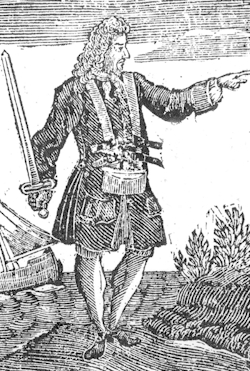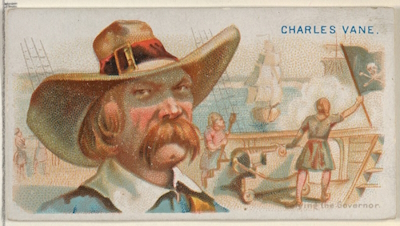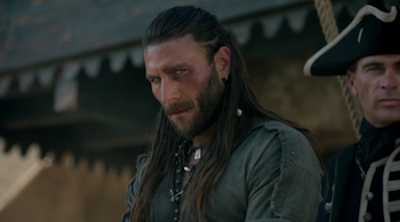“All the Pyrates who were found at this Colony of Rogues, submitted, and received Certificates of their Pardon except Captain Vane and his Crew, who, as soon as they saw the Men of War enter, slipp’d their Cable, set Fire to a Prize they had in the Harbour, and sailed out with their pyratical Colours flying, firing at one of the Men of War as they went off.” – Captain Charles Johnson, A General History of the Pyrates
Little is known about Charles Vane’s his early life, except that he was a sailor from Port Royal, although not believed have been born there. He is thought to have been born about 1690, probably in England. He was an outspoken Jacobite, who served as a privateer under Henry Jennings, in 1716 helping him to secure the gold from the Spanish treasure fleet that had sunk off the coast of Florida in a storm. He seems to have spent much time in Nassau, enjoying the decadent lifestyle there. Vane was a a successful pirate, capturing merchant vessels from Hispaniola to New York. He was known to be prone to violence, but some stories about his cruelty might have been exaggerated, and compared to later pirates like Ned Lowe, he seemed relatively reasonable, even if he was more brutal than was usual for members of the Flying Gang.
Refusing the pardon
 Vane really came into is own as a pirate when the news of the King’s pardon reached Nassau, being one of those to refuse clemency. He was disgusted when more than half the pirates, including his mentor Jennings, accepted it. Like Vane, many of those who rejected the pardon were Jacobites, and when news of it first arrived, they seized the fort from the loyalists, and raised the pirate flag. He and his supporters attempted to contact Jacobites in England for support and hoped to act as privateers on behalf of the exiled James Stuart. In February 1718, HMS Phoenix, a British ship captained by Vincent Pearse arrived in Nassau, where he was welcomed by the majority of the population. Pearse went after Vane, whose sloop, the Lark, was refitting nearby. Vane, who had only 16 men at the time, was captured, and although Vane claimed he was about to accept the pardon, Pearse didn’t believe him, preferring to lock him and the other captured pirates up. Those who accepted the pardon, such as Hornigold, begged for Vane’s freedom, not wanting to see them hanged and to avoid further trouble with those who were as of yet undecided. Vane agreed to try to convince more pirates to take the pardon, but it was only a ploy to buy himself time. Meanwhile, Pearse had confiscated Vane’s sloop. Vane eventually escaped the island and attracted more pirates to his cause, including his quartermaster Edward England and Calico Jack Rackham. Together they seized a sloop using rowing boats and returned to Nassau through the narrow eastern passage to the harbour. On their arrival the unrepentant pirates infuriated Pearse by openly mocking him. In response, the naval captain attempted to seize the pirate vessel in a surprise attack in rowing boats, but were driven off by musket fire. Pearse was frustrated by the support of given to Vane and the reluctance to aid the British officer by many of those who had accepted the pardon. The naval captain was powerless to prevent Vane from capturing prizes, including recapturing his previous vessel Lark. Three of Pearse’s own men even defected to Vane’s crew. Pearse finally decided to leave after his ship accidentally caught fire, but ran aground while leaving, finally managing to free their vessel to the jeers of the onlooking pirates. After Pearse left, Vane continued pirating unmolested. In a single cruise lasting until April 1718, he captured 12 vessels around the Bahamas, including the sloops William & Mary and Diamond off Rum Cay, on which it is said he mistreated some of the crew in order to find out where valuables were hidden.
Vane really came into is own as a pirate when the news of the King’s pardon reached Nassau, being one of those to refuse clemency. He was disgusted when more than half the pirates, including his mentor Jennings, accepted it. Like Vane, many of those who rejected the pardon were Jacobites, and when news of it first arrived, they seized the fort from the loyalists, and raised the pirate flag. He and his supporters attempted to contact Jacobites in England for support and hoped to act as privateers on behalf of the exiled James Stuart. In February 1718, HMS Phoenix, a British ship captained by Vincent Pearse arrived in Nassau, where he was welcomed by the majority of the population. Pearse went after Vane, whose sloop, the Lark, was refitting nearby. Vane, who had only 16 men at the time, was captured, and although Vane claimed he was about to accept the pardon, Pearse didn’t believe him, preferring to lock him and the other captured pirates up. Those who accepted the pardon, such as Hornigold, begged for Vane’s freedom, not wanting to see them hanged and to avoid further trouble with those who were as of yet undecided. Vane agreed to try to convince more pirates to take the pardon, but it was only a ploy to buy himself time. Meanwhile, Pearse had confiscated Vane’s sloop. Vane eventually escaped the island and attracted more pirates to his cause, including his quartermaster Edward England and Calico Jack Rackham. Together they seized a sloop using rowing boats and returned to Nassau through the narrow eastern passage to the harbour. On their arrival the unrepentant pirates infuriated Pearse by openly mocking him. In response, the naval captain attempted to seize the pirate vessel in a surprise attack in rowing boats, but were driven off by musket fire. Pearse was frustrated by the support of given to Vane and the reluctance to aid the British officer by many of those who had accepted the pardon. The naval captain was powerless to prevent Vane from capturing prizes, including recapturing his previous vessel Lark. Three of Pearse’s own men even defected to Vane’s crew. Pearse finally decided to leave after his ship accidentally caught fire, but ran aground while leaving, finally managing to free their vessel to the jeers of the onlooking pirates. After Pearse left, Vane continued pirating unmolested. In a single cruise lasting until April 1718, he captured 12 vessels around the Bahamas, including the sloops William & Mary and Diamond off Rum Cay, on which it is said he mistreated some of the crew in order to find out where valuables were hidden.
Vane flees Nassau
 Vane sailed back to Nassau on 28th April 1718 to find Blackbeard had also returned there. He tried to persuade Blackbeard to help defend the island, but to no avail as the other pirate captain thought it was a lost cause. Vane then made himself governor on behalf of the exiled James Stuart, but on realising there would be no Jacobite reinforcements, decided it might be better to flee the Bahamas. In May 1718 he went in search of better ship before doing so. He captured several vessels, inluding a 14-ton sloop, Richard & John, which had previously supplied pirates in Nassau; a 20-gun French ship, which he made his flagship; a brigantine called St. Martin carrying a rich cargo, including alcohol; he also captured several other merchant sloops in the Bahamas. Vane had soon built up his own small fleet with Edward England commanding one of the sloops and Jack Rackham as his quartermaster. Vane had control of Nassau and was planning to head to Brazil when Woodes Rogers arrived on 24th July 1718. At first, Vane offered to take the pardon if he could keep his ill-gotten gains, but the letter he sent to Rogers stating this was probably just a distraction. Vane’s French flagship was too big to leave by the narrow route, the wider entrance being blocked by Rogers small fleet, so during the night Vane made his daring escape, sending his burning flagship towards Roger’s own ship, the Delicia, which narrowly escaped unscathed after withdrawing from the harbour. Vane then commandeered a 24-gun sloop called the Katherine belonging to another pirate, Charles Yeats, and slipped out through the narrow passage before Rogers returned. The Buck pursued the escaping pirates, but was forced to give up the chase. Vane later threatened to return and burn Nassau to the ground. Rogers sent a former pirate, Captain Benjamin Hornigold to hunt him down before he could make good on his promise.
Vane sailed back to Nassau on 28th April 1718 to find Blackbeard had also returned there. He tried to persuade Blackbeard to help defend the island, but to no avail as the other pirate captain thought it was a lost cause. Vane then made himself governor on behalf of the exiled James Stuart, but on realising there would be no Jacobite reinforcements, decided it might be better to flee the Bahamas. In May 1718 he went in search of better ship before doing so. He captured several vessels, inluding a 14-ton sloop, Richard & John, which had previously supplied pirates in Nassau; a 20-gun French ship, which he made his flagship; a brigantine called St. Martin carrying a rich cargo, including alcohol; he also captured several other merchant sloops in the Bahamas. Vane had soon built up his own small fleet with Edward England commanding one of the sloops and Jack Rackham as his quartermaster. Vane had control of Nassau and was planning to head to Brazil when Woodes Rogers arrived on 24th July 1718. At first, Vane offered to take the pardon if he could keep his ill-gotten gains, but the letter he sent to Rogers stating this was probably just a distraction. Vane’s French flagship was too big to leave by the narrow route, the wider entrance being blocked by Rogers small fleet, so during the night Vane made his daring escape, sending his burning flagship towards Roger’s own ship, the Delicia, which narrowly escaped unscathed after withdrawing from the harbour. Vane then commandeered a 24-gun sloop called the Katherine belonging to another pirate, Charles Yeats, and slipped out through the narrow passage before Rogers returned. The Buck pursued the escaping pirates, but was forced to give up the chase. Vane later threatened to return and burn Nassau to the ground. Rogers sent a former pirate, Captain Benjamin Hornigold to hunt him down before he could make good on his promise.
Vane on the open sea
Vane captured several vessels after leaving Nassau, including a sloop called the John and Elizabeth and a 12-gun brigantine, which he took as his own renaming it the Ranger. The pirates set up a hideout in the Abaco Islands, north of New Providence and were supplied by sympathisers from Nassau. In August Vane blockaded Charleston and captured several merchant vessels there. It was at this time that Charles Yeats, dissatisfied with being treated as an inferior and still upset that Vane had seized his ship, Katherine, departed on unfriendly terms. taking a brigantine and 90 slaves, both pirate vessels even exchanging broadsides when Vane attempted to prevent Yeats’ departure. After Yeats had fled, Vane visited Blackbeard at Ocracoke Inlet in October 1718 to try to persuade him to attack Nassau, but Blackbeard refused. By now, Vane had a small fleet under his command, with which he attacked and plundered the island of Eleuthera out of frustration at being unable to reclaim Nassau, remaining there for a month. After leaving Eleuthera in November 1718, the pirates encountered a French frigate in the Windward Passage between Cuba and Hispaniola, which being outgunned Vane refused to attack. He was voted down by the crew and is said to have been replaced as captain by Jack Rackham, who is thought to have been his quartermaster. He was allowed to leave leave with sixteen others, including his first mate Robert Deal, in a small sloop. They then sailed to the Bay Islands off the coast of Honduras where they captured some small vessels.
Vane’s fate
 In February 1719, Vane was caught in a hurricane in the Bay Islands and was shipwrecked on an uncharted, uninhabited island, the rest of the crew, except for possibly one other, died in the catastrophe. He survived only because of the generosity of some turtle hunters, who frequented the island. A merchant ship arrived captained by the ex-pirate Holford, who didn’t trust Vane, leaving him on the island and informing him that if Vane was still there when he returned in a month’s time he would take him to Jamaica to be hanged. When another English ship arrived at the island to collect water, Vane tried joined the crew under a false name, but was recognized by Holford, who was an associate of the captain of Vane’s new vessel, on his return. Upon being discovered Vane was promptly arrested and brought to Jamaica, where he was eventually tried and hanged in March 1721 at Gallows Point in Port Royal. His corpse was hung in chains on the small island of Gun Cay off the coast of Port Royal, signifying the end of the defiant and notorious pirate captain.
In February 1719, Vane was caught in a hurricane in the Bay Islands and was shipwrecked on an uncharted, uninhabited island, the rest of the crew, except for possibly one other, died in the catastrophe. He survived only because of the generosity of some turtle hunters, who frequented the island. A merchant ship arrived captained by the ex-pirate Holford, who didn’t trust Vane, leaving him on the island and informing him that if Vane was still there when he returned in a month’s time he would take him to Jamaica to be hanged. When another English ship arrived at the island to collect water, Vane tried joined the crew under a false name, but was recognized by Holford, who was an associate of the captain of Vane’s new vessel, on his return. Upon being discovered Vane was promptly arrested and brought to Jamaica, where he was eventually tried and hanged in March 1721 at Gallows Point in Port Royal. His corpse was hung in chains on the small island of Gun Cay off the coast of Port Royal, signifying the end of the defiant and notorious pirate captain.
